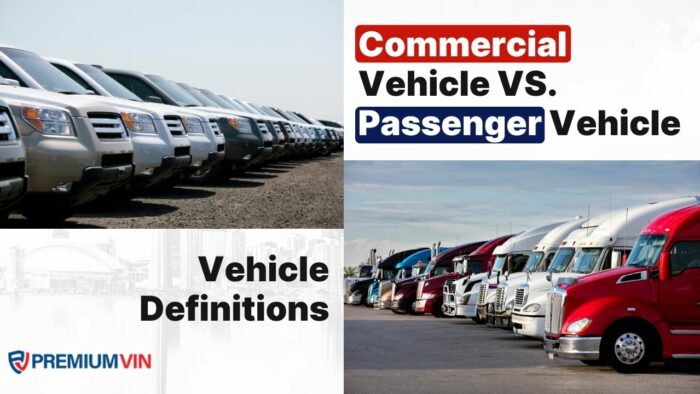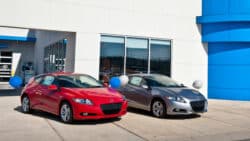A A non-commercial vehicle is a vehicle whose use is not intended for money-making purposes, such as carrying goods or passengers for a fare. The most common types of non-commercial vehicles include private cars, motorcycles, SUVs, and vans. Other forms may consist of recreational vehicles.
This, however, is not always the case because some of the aforementioned vehicles can also serve commercial purposes. In some countries, the joint family SUV might serve as a Taxi; even the Ford F-150 used by families can serve as a pickup truck for traders.
On the other hand, some vehicles are undeniably commercial, such as buses, trailers, and most heavy-duty vehicles. This distinction between non-commercial and commercial vehicles is crucial to understanding their types and uses.
DID YOU KNOW?
The trucking industry in the United States alone is responsible for transporting 80% of all freight deliveries nationwide! That’s a massive amount of goods these commercial vehicles deliver yearly. [statistic on the trucking industry in the US]
Commercial Vehicles: A Comprehensive Overview
Commercial vehicles are a broad category encompassing any vehicle used for business purposes. Here’s a detailed breakdown of the various types, categorized into on-road and off-road commercial vehicles:
On-road Commercial Vehicles:
- Trucks:
- Light Trucks: This includes pickup trucks and small trucks used for local deliveries and the transportation of goods.
- Medium Trucks: Used for more substantial loads, including larger delivery trucks and utility trucks.
- Heavy Trucks include semi-trailer trucks, often used for long-haul transportation of goods across cities or states.
- Specialized Trucks: Examples include garbage trucks, tankers for transporting liquids, and refrigerated trucks for perishable goods.
- Vans:
- Cargo Vans: Enclosed vehicles are used primarily for transporting goods and are commonly used by delivery services.
- Passenger Vans: Used to transport groups of people, often employed by shuttle services, tour companies, and for group transport.
- Specialized Vans: This includes vans for specific business uses, such as mobile workshops, food trucks, or ambulances.
- Buses:
- City Buses: These are used for public transportation within cities, accommodating many passengers.
- Intercity Buses: Designed for long-distance travel, providing transportation between cities or states.
- School Buses: Used for transporting students to and from school.
- Tour Buses: These are equipped for comfortable travel over long distances and are often used by tour companies.
- Taxis:
- Traditional Taxis: Vehicles licensed to transport passengers for a fare commonly found in urban areas.
- Ride-Sharing Vehicles: This category includes cars used for services like Uber and Lyft, which operate similarly to traditional taxis but are often booked through apps.
- Delivery Trucks:
- Parcel Delivery Trucks: These are used by companies like UPS, FedEx, and Amazon for package deliveries.
- Food Trucks: Mobile units equipped to prepare and sell food.
- Concrete Mixers: Specialized trucks used in construction to deliver and pour concrete.
READ ALSO: Hino truck VIN decoder
Off-road Commercial Vehicles:
- Construction Equipment:
- Bulldozers: Powerful tracked vehicles used to push large quantities of soil, sand, rubble, or other materials.
- Excavators: Equipped with a bucket and arm for digging and moving earth.
- Cranes: Used for lifting and moving heavy objects, essential for building construction.
- Mining Equipment:
- Haul Trucks: Large vehicles transport materials like ore and minerals from mining sites.
- Loaders: These are used to load materials into trucks or move them around mining sites.
- Agricultural Equipment:
- Tractors: Versatile vehicles used for various farming tasks, including plowing, planting, and towing equipment.
- Combines: Used to harvest crops efficiently, combining the tasks of reaping, threshing, and winnowing into a single process.
- Sprayers: These apply pesticides, herbicides, and fertilizers to crops.
This is not an exhaustive list, but it provides a comprehensive overview of the many different types of commercial vehicles. The specific types will vary depending on the industry and the business’s needs. Commercial vehicles are crucial in the global economy, from delivery trucks navigating city streets to heavy machinery working in remote mines.
DID YOU KNOW?
Although they might seem like behemoths of the road, large trucks can take nearly 200 feet to stop at highway speeds! This is due to their immense weight, up to 80,000 pounds or more. So, remembering extra stopping distance is crucial when sharing the road with commercial vehicles. [statistic on stopping distance of large trucks]
What to do before buying a used commercial vehicle
Define Your Needs:
- What will you be using the car for?
- What’s your budget for purchase, maintenance, and insurance?
Research the Vehicle:
- Identify the right vehicle type based on your needs.
- Research different makes models and years to understand their pros, cons, and typical mileage range.
- Get a vehicle history report to check for accidents, ownership history, and liens.
Inspect the Vehicle Thoroughly:
- Schedule a professional pre-purchase inspection by a qualified mechanic.
- Inspect visually for signs of rust, leaks, damage, or excessive wear.
- Test the vehicle and pay attention to handling, braking, and warning lights.
Check the Paperwork: Verify the seller’s ownership with a clear title. Review all maintenance records for consistent servicing and major repairs. Understand the warranty (if any) and its coverage duration.
Additional Considerations:
Explore financing options for commercial vehicles, as interest rates might differ from consumer car loans. Get quotes for commercial vehicle insurance based on the specific vehicle and your intended use. Ensure parts for the chosen vehicle are readily available and affordable in your area to minimize repair downtime.
Related Terms Explained
- Motor Vehicle: This is the broadest term, encompassing any self-propelled vehicle on a roadway, including cars, trucks, motorcycles, and even some buses.
- Passenger Car: This refers specifically to motor vehicles designed primarily for transporting people, with a seating capacity of less than 15 passengers (including the driver).
- Commercial Vehicle: This category includes any vehicle used for business purposes, regardless of size. It can encompass large trucks and vans used for transporting goods, as well as ride-sharing vehicles or taxis that carry passengers for hire.
- Vehicle Registration: This is the official process of registering your motor vehicle with the Department of Motor Vehicles (DMV) in your state. Registration fees and requirements can vary depending on the vehicle type (commercial vs. passenger car).
- Department of Motor Vehicles (DMV): This is a government agency responsible for vehicle registration, driver licensing, and enforcing traffic laws in your state. They also play a crucial role in ensuring vehicles meet certain safety standards. These standards encompass factors like brake performance, emissions control, and seatbelt functionality, all designed to keep drivers and passengers safe on the road.
Difference between a commercial and a Passenger: Figuring out if your vehicle falls under commercial regulations can be confusing. Here in California, the California DMV uses specific criteria to define commercial vehicles. It’s not just about the purpose – a vehicle can be considered commercial based on its gross vehicle weight rating (GVWR), even if you use it for personal reasons.
The GVWR is the maximum weight a vehicle is designed to carry, including passengers and cargo. Federal motor carrier regulations also come into play, but typically focus on vehicles with a GVWR exceeding 10,001 pounds.
However, California DMV considers a vehicle commercial if it’s designed to transport more than 15 people, regardless of weight, or if it’s designed for transporting goods, even for personal use. To avoid any confusion, it’s always best to check with the California DMV for their most up-to-date vehicle definitions to ensure you’re following the proper regulations.







